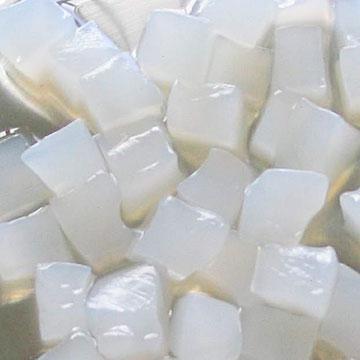
Picture of Nata de Coco Philippine
The industry then flourished in Laguna, Batangas, Quezon, Iloilo, Cagayan de Oro, Cavite and many other places in the Philippines. Through the years, nata de coco enjoy the fair share of the local and international market but it was only during the last couple of years that nata de coco had a surprising boom in the export market.
There was this sudden demand to acquire data on nata technology among entrepreneurs. With Japan, importing an estimated total of $170,320 worth of nata in 1991 from the Philippines. And Taiwan, $2.1 million in 1992. It is quiet evident that the demand for nata de coco has soured.
What is Nata de Coco?
Nata de coco is cellulosic, white, thick, creamy yellow substance formed by a bacterium called Acetobacter xylinum. This living organism can be isolated in rotten fruits and vegetables. It grows on the surface of sugar and rich coconut water or coconut milk. Nata de coco in syrup has a fresh taste, translucent color and nutritive value because of its high fiber content. It is low in calories, giving only 80 kilo-calories per 100 grams serving and only 1 kilo-calorie per 100 grams if taken plain.
Nata de coco Production
Production of nata is basically simple but many producers failed to achieve the desired nata quality because of their negligence following proper manufacturing practices in processing and sanitation.
Some of the most common mistakes would be those in which the product would turn out to be thin and soft or too thick and firm or with holes or with the bottom portion of nata soft or discolored. Some may also have fermented for other kinds of odors. Or perhaps the nata itself would not grow or would simply be embedded with cream. Thus if nata is produced under unfavorable conditions, chances are the undertaking will eventually prove more complicated and costly than expected.
The Proper Way of Nata de coco Production
How to Make a Nata de coco?
The first thing to do is to prepare all the necessary materials and utensils for production. We would need a 1 kilogram of grated coconut around 10 to 11 months old. 12 liters of potable water. 600 grams refined sugar. 500 millimeters of coconut water. 325 millimeters of Glacial Acetic Acid. And 2 liters Nata starter.
Utensils to be used are 2 pales with 25 liters capacity, a wooden ladle, a meter of cheese cloth, weighing scale, 5 gallon sized containers, 15 plastic trays size 8 by 11 by 3 inches, liquid measuring cups, a flask that can contain 1 liter liquid, brown paper and some rubber bands.
We take the kilo of grated coconut and mix it with 12 liters of potable water. This mixture is strained afterwards using the clean cheese cloth. Then we add the rest of the ingredients in their prescribed amounts. This would be the refined sugar, coconut water, Glacial Acetic Acid and the nata starter.
The produced mixture is poured into clean sterile fermenting basements or jars about 1 inch deep. We set aside a portion of this mixture to be used as starter after 3 to 5 days. Fermentation lasts from 5 to 10 days. After which, we are ready to harvest the nata. Harvested nata is finally washed
Nata de coco Finished Product and its Uses
Nata de coco is commonly consumed as a food item in the form of desserts, candies, ingredients in salads, fruit cocktails, ice cream, halo-halo, sorbetes, and beverage like juices, dairy products, ketchup and sauces. Nata has also served as probable texture modifiers for frozen foods, baked products, sauces and others.
Nata de coco Production's Waste Management
Nata production has not discounted the aspect of proper waste disposal of materials. The following are some safe tips to follow in disposing used materials from nata production. The "sapal" (waste grated coconut) can be reused and recycled by other sectors to form among others such products as biogas, animal feeds, fertilizer, dietary fiber, flour, snack foods and other baked products.
The washings recovered after harvesting the raw nata are not disposed of directly to the waterways. Instead, a solution known as apple or lime is added which acts as neutralizer for the washings. Meanwhile coconut water can be recycled into buko juice, vinegar, coco gel, alcohol and other industrial products can be disposed of by lagooning or by the formation of sedimentation ponds wherein the waste water is allowed to evaporate.
Nata de coco may appear to be just another backyard technology to some people. But those who have succeeded in the nata trade will not only discover its tremendous impact in industry and economy but also gain prominence for the coconut products and world trade.
- https://www.affordablecebu.com/